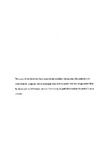Modelling, testing and design, of a surface piercing propeller drive
| dc.contributor.author | Dyson, Peter Kevin | |
| dc.contributor.other | Faculty of Science and Engineering | en_US |
| dc.date.accessioned | 2011-06-28T14:18:26Z | |
| dc.date.available | 2011-06-28T14:18:26Z | |
| dc.date.issued | 2000 | |
| dc.identifier | Not available | en_US |
| dc.identifier.uri | http://hdl.handle.net/10026.1/507 | |
| dc.description.abstract |
Surface Piercing Propellers (SPPs) are used for high speed vessels in order to avoid the high appendage drag and cavitation problems associated with conventional propellers. The set of forces to which they are subjected is far more complex and demanding than conventional propellers. Not only are the forces much increased, but each goes through large transients as successive blades pass through the water. This project has endeavoured to improve the techniques and data available to the designer, giving more confidence in the design of the shaft and bearing system. Performance data has been measured on model propellers including both mean values and transients. Torque and thrust figures from these tests correlate well with results for similar propellers tested by previous workers. Mean side and vertical forces have been measured across a range of operating conditions and for different propellers. Each is typically between 20% and 40 % of thrust, and they have a considerable impact on the design of the propeller shaft. The transients are analysed using frequency spectra to establish the nature and magnitude of the propeller excitation. The first two harmonics of blade rate are found to be dominant and peak to peak fluctuations may typically be 50% of mean values, frequently more. Comparisons are drawn between different blade skews and also different numbers of blades across a range of operating conditions. The experimental data may be used to determine the input to a dynamic finite element model of the propeller, shaft and bearing system which has been developed. This permits designers to apply not only the steady set of forces to the system, but also the transient excitations. Thus a clearer picture can be gained of the fatigue loading imposed. A transient loading model for a SPP has been developed and compared with the experimental results. This enables evaluation of the effect of changes to propeller geometry on excitation loads. Taken together, the experimental data, finite element model and transient load model significantly extend the understanding of the behaviour of SPP systems and provide the designer with a useful tool for determining the complex transient stresses under which these systems operate. | |
| dc.language.iso | en | en_US |
| dc.publisher | University of Plymouth | en_US |
| dc.title | Modelling, testing and design, of a surface piercing propeller drive | en_US |
| dc.type | Thesis | |
| dc.identifier.doi | http://dx.doi.org/10.24382/3547 |
Files in this item
This item appears in the following Collection(s)
-
01 Research Theses Main Collection
Research Theses Main


